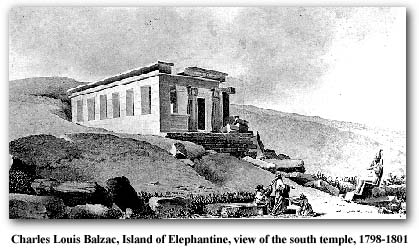Elephantine Island
 Elephantine Island is the largest of the Aswan area islands, and is one of the most ancient sites
in Egypt, with artifacts dating to predynastic periods. This is probably due to its location at the
first Cataract of the Nile, which provided a natural boundary between Egypt and Nubia. As an
island, it was also easily defensible. In fact, the ancient town located in the southern part of the
island was also a fortress through much of it's history. At one time, there was a bridge from the
mainland to the island. Elephantine Island is the largest of the Aswan area islands, and is one of the most ancient sites
in Egypt, with artifacts dating to predynastic periods. This is probably due to its location at the
first Cataract of the Nile, which provided a natural boundary between Egypt and Nubia. As an
island, it was also easily defensible. In fact, the ancient town located in the southern part of the
island was also a fortress through much of it's history. At one time, there was a bridge from the
mainland to the island.
Elephantine is Greek for elephant. In ancient times, the Island, as well as the southern town,
was called Abu, or Yabu, which also meant elephant. The town has also been referenced as
Kom, after it's principle god of the island, Khnum (Khnemu). It is believed that the island
received it's name because it was a major ivory trading center, though in fact, it was a major
trading post of many commodities. There are large boulders in the river near the island which
resembled bathing elephants, particularly from afar, and this too has been suggested as a
reason for the island's name.
The island is very beautiful, and while many of the artifacts there are in ruin, there is still
considerable to see. One of it's main attractions is it's Nilometer, which is one of only three on
the Nile, which was used to measure the water level of the Nile as late as the nineteenth
century. There has been an ongoing excavation at the town for many years by the German
Archaeological Institute, and some of the finds along with many other island artifacts, including
a mummified ram of Khnum, are located in the Elephantine Museum. Another major attraction
is the ruins of the Temple of Khnum. Elephantine Island was considered to be home of this
important Egyptian god, and while this structure dates back to the Queen Hatshepsut of the
18th Dynasty, there are references to a Temple of Khnum on the island as early as the 3rd
Dynasty. There are also ruins of a Temple of Satet, who was Khnum's female counterpart (the
three local deities were foremost Khnum, but also Satet and a local Nubian goddess Anqet.
These gods were worshipped here since the earliest dynasties), also build by Queen
Hatshepsut, a shrine to Hekayib from the 6th Dynasty, a local governor who was deified after
his death. His cult flourished during the middle kingdom, and some fine statues from the shrine
are now in the museum. You will also find a 3rd Dynasty granite step pyramid which is now
just visible, and to the north, the mud-brick vaults of the late period which housed the bodies
of the royal rams. On the south end of the island is a small one room Ptolemaic temple which
was constructed from materials removed from the Kalabsha Temple. Here, there are
decorations attributed to the Nubian Pharaoh Arkamani from the 3rd century BC The building
seems to have been finished by the Romans with reference to Caesar Augustus.
 Other artifacts and archaeological sites have been removed or destroyed. Prior to 1822, there
were temples of Thutmose III and Amenhotep III, both of which were relatively intact, but
they were destroyed in that year by the Turkish government. A rare calendar, known as the
Elephantine Calendar, dating to the reign of Tuthmosis III, was found in fragments, and a
Papyrus dating to the 13th dynasty and known as the Elephantine Papyrus was also
discovered. It is unclear where these artifacts are currently located. A stela with inscriptions
commemorating the repairs made on a 12th Dynasty fortress which honored Senwosret III
was also found, and is now in the British Museum. Other artifacts and archaeological sites have been removed or destroyed. Prior to 1822, there
were temples of Thutmose III and Amenhotep III, both of which were relatively intact, but
they were destroyed in that year by the Turkish government. A rare calendar, known as the
Elephantine Calendar, dating to the reign of Tuthmosis III, was found in fragments, and a
Papyrus dating to the 13th dynasty and known as the Elephantine Papyrus was also
discovered. It is unclear where these artifacts are currently located. A stela with inscriptions
commemorating the repairs made on a 12th Dynasty fortress which honored Senwosret III
was also found, and is now in the British Museum.
Elephantine Island is a beautiful place to visit, with wonderful gardens and some truly
significant artifacts. It is also a good place to spend some leisure time, wondering among the
Nubian villages where the people are friendly and the houses are often very colorful. The
houses often have paintings or carved with a crocodile at the bottom, a fish in the middle and a
man on top, with a woman's hand made of brass as a door knocker between the fish and man.
Others will have a sacred black cube of Mecca, with a painting depicting the means of the
owner's pilgrimage to Mecca.
|





